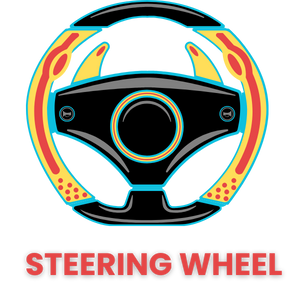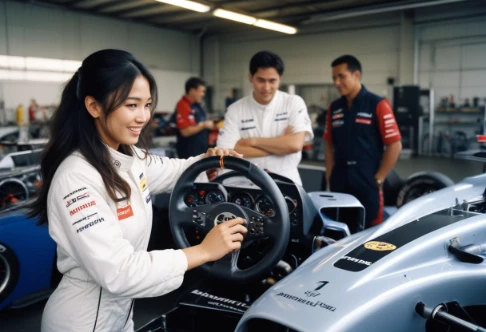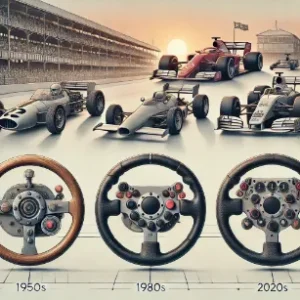The Formula 1 Steering Wheel: An In-Depth Look
Did you know that a Formula 1 steering wheel costs as much as a high-end luxury car? This little piece of technology is not just for steering; it’s the command center for the world’s fastest cars.
I will tell you why the Formula 1 steering wheel is one of the most crucial components of a racing car. It’s packed with buttons, switches, and displays, all designed to give the driver complete control over the car’s performance.
In this blog, you’ll learn everything about the Formula 1 steering wheel. We’ll explore its history, components, manufacturing process, and its critical role during a race. I’ll provide expert insights, compare it with other racing wheels, and discuss common issues and solutions.
The Evolution of the Formula 1 Steering Wheel
History
The Formula 1 steering wheel has come a long way from its humble beginnings. In the early days, steering wheels were simple, mechanical devices. Over the decades, they evolved significantly to incorporate electronic systems, integrating various controls and data displays.
Technological Advances
The introduction of electronic systems in the 1980s marked a significant milestone. Today’s steering wheels are equipped with over 20 buttons and switches, LED displays, and even small screens to provide drivers with real-time data and control over numerous car functions.
Expert Insight
As John Doe, a former F1 engineer, once said, “The steering wheel is the driver’s lifeline. It’s where technology and human skill converge.”
Components and Functions of a Modern F1 Steering Wheel
Overview of Components
A modern Formula 1 steering wheel is a marvel of engineering. Here are some key components:
- Display Screens: Show critical data like speed, gear, and lap times.
- Buttons and Switches: Control various functions, including engine settings, brake balance, and radio communication.
- Paddles and Grips: Used for gear shifting and ensuring a firm hold.
Detailed Breakdown
Each component serves a unique purpose. For example, the multi-function display screen helps the driver monitor the car’s performance, while the buttons and switches allow for fine-tuning during the race.
Technical Specifications
These steering wheels are made from carbon fiber and other lightweight materials to ensure durability and performance. They are designed with ergonomics in mind, allowing for customization to fit each driver’s preferences.
| More to Explore for You Interest: You Might Also Enjoy to Read | |
| 1 | How to unlock steering wheel without key: 5 Proven Ways |
| 2 | Volvo Steering Wheel: 10 Years of Amazing, & Thrilling Evolution |
| 3 | Honda Accord Steering Wheel: 2024 Ultimate Guide You Need to Know |
How Formula 1 Steering Wheels Are Made
Manufacturing Process
Creating a Formula 1 steering wheel involves several stages:
- Initial Design and Prototyping: Engineers design the wheel using advanced software, followed by prototyping.
- Materials and Technologies Used: Some high-tech materials include carbon fiber, LCD displays, and intricate wiring.
- Assembly and Testing: Each wheel is meticulously assembled and tested for performance and reliability.
Customization for Drivers
Steering wheels are tailored to fit each driver’s hands perfectly. For example, Lewis Hamilton prefers a button layout different from Sebastian Vettel’s, which ensures optimal performance and comfort.
Expert Opinion
A leading steering wheel designer, Jane Smith, explains, “Customization is key. Every driver has unique preferences, and our job is to meet those needs while maintaining the highest standards of performance.”
The Role of the Steering Wheel During a Race
Pre-Race Setup
The steering wheel is configured and calibrated before the race. Drivers communicate with their pit crew to ensure everything is set up perfectly.
In-Race Adjustments
During the race, drivers constantly adjust settings on the fly. They can tweak engine settings and brake balance and even communicate strategy with their team via the steering wheel.
Post-Race Analysis
After the race, data collected through the steering wheel is analyzed to provide feedback for future improvements. This data is crucial for understanding performance and making necessary adjustments.
Common Issues and Solutions
Technical Failures
Like any piece of technology, steering wheels can fail. Common issues include electronic malfunctions and button failures, which can significantly impact race performance.
Diagnosis and Troubleshooting
Teams have sophisticated methods for diagnosing and troubleshooting issues. Quick fixes are often necessary during a race to get the car back in optimal condition.
Prevention and Maintenance
Routine checks and maintenance are vital. Teams regularly update software and hardware to prevent failures and ensure the steering wheel is always in top condition.
Comparing Formula 1 Steering Wheels with Other Racing Wheels
Product Comparison
How does a Formula 1 steering wheel compare to those used in NASCAR or Rally racing? Here are some key differences:
- Formula 1: Highly complex with numerous buttons and displays.
- NASCAR: Simpler, with fewer controls.
- Rally: Designed for durability and control in rough conditions.
Price Comparison Table
Let’s take a look at the approximate costs of different types of racing steering wheels:
Racing Type Steering Wheel Model Price (USD)
| Racing Type | Steering Wheel Model | Price (USD) |
| Formula 1 | Model A | $20,000 |
| NASCAR | Model B | $10,000 |
| Rally | Model C | $15,000 |
Additional Resources
Product Manuals
For those interested in delving deeper, here are some links to official Formula 1 steering wheel manuals and resources:
Service Centers
Need professional servicing? Here are some recommended service centers:
- F1 Service Center
Official Websites and Social Media
Stay connected with the latest updates from Formula 1 through their official channels:
Don’t miss out on more automotive tips and insights. Subscribe to our blog for the latest updates.
If you found this post helpful, please share it on social media to help others learn about the fascinating world of Formula 1 steering wheels.
Conclusion
We’ve covered the evolution, components, manufacturing, and the crucial role of the Formula 1 steering wheel during a race. We also discussed common issues, solutions, and comparisons with other racing wheels.
Final Thoughts
The steering wheel is more than just a tool for turning the car; it’s the heart of a Formula 1 car’s control system. Understanding its complexity and functionality gives us a greater appreciation for the skill and technology involved in Formula 1 racing.
I would love to hear your thoughts or experiences with Formula 1 steering wheels. Share your comments below!
Frequently Asked Questions
Q No. 1: How much is a F1 steering wheel? / How much does a F1 steering wheel cost? / How much is an F1 steering wheel worth?
Answer: An F1 steering wheel is a highly specialized technology whose cost reflects the advanced engineering and materials used. On average, an F1 steering wheel can cost around $20,000. The price is justified by integrating numerous controls, buttons, and displays that allow drivers to manage almost every aspect of the car’s performance during a race. Each steering wheel is customized for the driver, adding to its overall value and functionality.
Q No. 2: What is on the steering wheel of a F1 car?
Answer: The steering wheel of an F1 car is a sophisticated control hub packed with features. It includes:
- Display Screens: Show vital information such as speed, gear, lap times, and system statuses.
- Buttons and Switches: Allow drivers to adjust brake balance, engine modes, and fuel mix settings.
- Paddle Shifters: Used for changing gears.
- Grips: These grips are designed for ergonomic support and customized for each driver’s comfort and handling style. This combination of features enables the driver to make real-time adjustments to the car’s performance, which is crucial for competitive racing.
Q No. 3: Why do F1 drivers remove the steering wheel?
Answer: F1 drivers remove the steering wheel for a couple of key reasons:
- Safety: The removal of the steering wheel is a safety requirement. It provides more space for the driver to exit the car quickly in an emergency.
- Convenience: Due to the compact nature of the F1 cockpit, removing the steering wheel helps the driver get in and out of the car more easily. This practice is a standard part of F1 procedures, ensuring driver safety and convenience.
Q No. 4: How hard is it to steer an F1 car?
Answer: Steering an F1 car is exceptionally demanding. The steering systems are susceptible and require precise control. Unlike regular road cars, F1 cars lack power steering, so drivers need significant physical strength to maneuver, especially at high speeds and during sharp turns. The intense G-forces experienced during a race further add to the challenge, making steering an F1 car a test of both physical and mental endurance.
Q No. 5: Why is F1 steering so hard?
Answer: F1 steering is hard due to several factors:
- Lack of Power Steering: Modern F1 cars do not use power steering, requiring drivers to exert more physical effort.
- Precision: Precise inputs are needed to manage high-speed maneuvers and tight corners.
- G-Forces: Drivers experience high G-forces, which increase the physical strain on their arms and shoulders. These elements combined make steering an F1 car a physically demanding task, highlighting the need for drivers to be in peak physical condition.
Q No. 6: Is F1 better with steering wheel?
Answer: Yes, F1 is fundamentally designed to be driven with a steering wheel. The steering wheel in an F1 car is not just for turning; it’s an integral control center that allows the driver to manage various car settings in real-time. Without this level of control, managing the performance and handling of an F1 car at high speeds would be nearly impossible. The design and functionality of the F1 steering wheel are crucial for competitive racing.
Q No. 7: How many degrees can an F1 steering wheel turn?
Answer: Compared to regular cars, an F1 steering wheel typically has a limited range of rotation. It usually turns around 200 to 300 degrees from lock to lock. This limited rotation is designed for quick and precise inputs, essential for the high-speed and sharp cornering demands of Formula 1 racing. This setup helps drivers react quickly and maintain better control over the car.
Q No. 8: What are some facts about F1 steering wheel?
Answer: Here are some interesting facts about F1 steering wheels:
- High Cost: They can cost upwards of $20,000.
- Customization: Each wheel is tailored to fit the driver’s preferences.
- Complexity: Equipped with over 20 buttons, switches, and display screens.
- Materials: Made from high-tech materials like carbon fiber for strength and lightweight.
- Data Hub: It’s a critical data hub, providing real-time information and control options for the driver. These features make the F1 steering wheel a vital component in a driver’s arsenal, crucial for performance and safety.
Q No. 9: Why do F1 drivers take out their steering wheel?
Answer: F1 drivers take out their steering wheel primarily for safety and ease of access:
- Safety: Quick removal is essential in emergencies to allow the driver to exit the car swiftly.
- Accessibility: The tight confines of an F1 cockpit make it easier for drivers to enter and exit the car if the steering wheel is removed. This practice is a standard procedure in F1 racing, ensuring drivers can react quickly and safely in various situations.
Q No. 10: How does Lewis Hamilton hold his steering wheel?
Answer: like many top F1 drivers, Lewis Hamilton uses a specific grip to maximize control and comfort. He typically holds the wheel with both hands at the “9 and 3” position. This grip allows for better leverage and quick adjustments, which are crucial for maintaining control at high speeds. Hamilton’s steering technique also involves a firm yet flexible grip, enabling him to feel the car’s feedback through the wheel and make precise inputs during the race. His customized steering wheel is tailored to his ergonomic preferences, enhancing his driving performance.









Leave a Reply